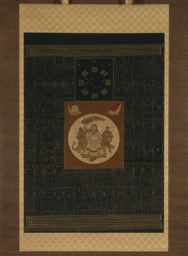I know that the above image is too small to make out any details well, but there are some interesting things about this painting, which is reproduced in better detail in Taoism and the Arts of China. The painting features Zhenwu or Xuan Tian Shang Di in the center.
Above him are the eight trigrams or Bagua. In the middle of the trigrams is the Bei Dou (Northern Dipper) or Big Dipper (Ursa Major) constellation. The background of the scroll consists of 72 talismans, which are too indistinct to see in this version of the image.
The scroll was painted in the 17th or early 18th century, during the Qing Dynasty. Stephen Little observes that it may have been produced outside of China:
Stylistic features of this hanging scroll suggest that it may have been done outside China, perhaps in Korea. The present mounting is Japanese. At the same time, the content and iconography of the painting are consistent with Chinese images of the Perfected Warrior. (308)
Little uses the Xuantian Shangdi Qishen Lu (Record of the Opening of Sagehood by the Supreme Emperor of the Dark Heaven) from the Daoist Canon (Zhengtong Daozang), which was first printed in 1444 or 1445, as his primary source for understanding the painting.
Little writes that “One of the most important roles of Zhenwu, the Perfected Warrior, was to protect against malevolent spirits […] Te Perfected Warrior is shown here in this role” (308).
Little retells how Zhenwu’s first assignment upon attaining “a post in the celestial hierarchy” was to “subdue the north [the direction of the demon capital of Fengdu] … and put a stop to all the wicked demons under the heavens” (308). This was the battle discussed in a previous post.
After the battle, though, Zhenwu went to Laozi (the Old Master) to receive accolades, but Laozi told him that his work was not done:
[T]he Perfected Warrior’s accomplishment of the Way could not be foretold until the Lord of the Netherworld himself (Yenluowang or Yama) came with the Perfected Warrior before the Old Master to report that there were no longer souls in any of the hells.
Thereupon, the Perfected Warrior made a vow to take all the wickedness of the world upon himself, until there were no longer any demons or ghosts, or any souls left suffering. (308)
In line with this vow, the 72 talismans behind Zhenwu are mostly concerned with protection against demons:
These talismans are composed of stylized star-diagrams and talismanic script, and each talisman is accompanied by an inscription indicating its function.
The large majority of these talismans protect against demons; the second talisman, for example, protects against “abnormalities in the shape of pigs, cats, dogs, or all those that eat their own young,” while the forty-fifth talisman protects against “old trees that turn into sprites.” (308)
However, some of them have different functions:
Other talismans protect against all manner of social, natural, and supernatural disasters, from imprisonment and burglary to plagues and bad dreams.
A smaller number of talismans bring good fortune rather than protecting against bad; these help oneself and one’s family to live long, prosperous lives, and aid in such pursuits as attaining political office. (308)
Little’s conclusion is succinct:
The wide range of the talismans in the painting reflects the all-encompassing vow of the Perfected Warrior, and his special powers against all kinds of malevolent spirits. (308)

May 3rd, 2015 at 7:58 am
This is very interesting. Similar illustrations are also in the collections of a number of shrines in Japan, including Tensha Tsuchimikado Shintō Honchō 天社土御門神道本庁. However, in Japan the deity does not seem to be usually recognized as Xuantian Shangdi, but is referred to as Chintaku Reifu-jin 鎮宅霊符神 (Deity of the Talismans for Stabilizing the Home). Those with Buddhist inclinations will say the deity is the same as Myōken Bodhisattva 妙見菩薩 (deification of the Pole Star).
In the iconography it is seems pretty obvious it is Xuantian Shangdi though.
The 72 talismans can be found in the Daoist Canon as Taishang bifa zhenzhai lingfu 太上秘法鎮宅靈符 (“Powerful Talismans for Stabilizing the Home”).
A pdf of the text: http://goo.gl/FU3ZgT
HTML version: http://goo.gl/uQ9weK
May 22nd, 2015 at 10:32 pm
Thank you!